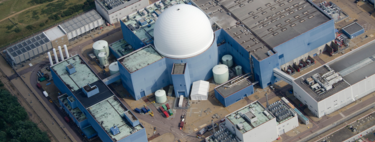The use of nuclear energy remains one of the most controversial issues in the energy debate. It is worldwide due to economic, social factors and concern for something very concrete: waste management. It seemed that the enormous deployment of renewables would end the debate, but the truth is that there are countries that continue to depend greatly on nuclear energy.
And this graph reflects it clearly:

Three blocks. The graph is the work of Visual Capitalist with data from the ‘Energy Institute Statistical Review of World Energy’ and the estimate is that nuclear plants generated 2,818 THW of electricity in 2024. Approximately 10% of the electricity generated throughout the world during the last year, but beyond the total, which allows us to see is that there are three very even and perfectly identifiable blocks.
On the one hand, that of the United States and Canada. Here Canada has ‘little’ to say, and also its centrals generated 3.6% less than the previous year, but the United States is still a giant. It generated 823 TWH that, put in context, represents about 30% of all global nuclear energy. It has 94 operational reactors and that huge amount of electricity accounted for 18% of the national total.
In the Asian block we have China standing out with 451 TWH produced, 3.4% more than the previous year, South Korea with 189 TWH and both Japan and India contributing, but with lower productions. And in the European bloc, France and Russia stand out above all, which among them have a much more similar production. The interesting thing here is to see the speed at which the world in a nuclear question moves.

Promoting nuclear. Because we have already seen that, although the US generated more electricity with the nuclear, it was a small percentage. If we look at the European block, we have that there are those who grow 4% (Sweden) and who decreases by 4% (Spain), but we have a France that increased the production of its centrals by 12.2%. With 57 operational reactors, if there is a country that depends on nuclear energy, that is France. It is estimated that 67% of its electricity comes from nuclear. Countries such as Slovakia, Belgium, Hungary or Bulgaria also depend largely on nuclear energy. In the case of Spain, 20% of its energy comes from these centrals.
But if we look at the Asian block, the thing changes. China promoted its nuclear generation in recent months, but Japan did it in 9.3% and India, which wants to consolidate as a new technological core worldwide, generated 13.3% more. In the Middle East highlights United Arab Emirates that, whose four reactors generated 22% of their electricity.
Old reactors. In total, it is estimated that there are 416 operational plants worldwide (France has the same as China, a fact that reflects the importance for the neighboring country) and a problem is that most are quite old reactors. Around two thirds of them are over 30 years old and, although the estimated life is usually between 30 and 40 years old, it is easy to prolong it more time with modifications and extensions.
New reactors. There are also about 70 reactors under construction. They are distributed, but most concentrate in Asia, especially in the two countries that are leading that world nuclear expansion: China and India. New reactors use refrigerants that can operate with more energy safety and efficiency, also generate less waste and have an estimated useful life of more than 50 years thanks to modular designs.
As we say, China is one of the countries that is best betting on this energy (despite the impulse that is also giving to renewables), and within its new plants, the fourth generation reactors stand out, such as the one used by molten salts or thorium. They are not the only ones, as the US, France and India are also investing in research programs to develop reactors that generate electricity from the thorium (three times more abundant than uranium)

Data centers. The truth is that, although sources such as renewables are still expanding, it seems that we are far from folding both fossil fuels and nuclear energy. Much of the fault is very demanding data centers in energy terms that even need a specific supply of gas or even coal in demands of demand peaks.
In fact, some of the main technological ones such as Amazon, Google or Microsoft announced plans to create or reactivate nuclear centrals to meet the energy need for their data centers for artificial intelligence. And all this while we look at a future in which the norm should be the SMR reactors … and the nuclear fusion is still on the horizon.
In WorldOfSoftware | Europe and Japan are working side by the greatest technical advance of humanity: the nuclear fusion reactor












